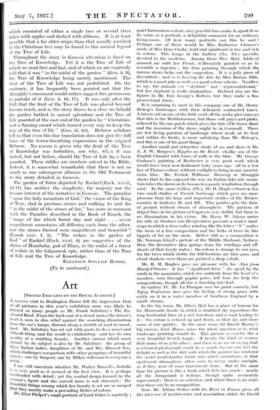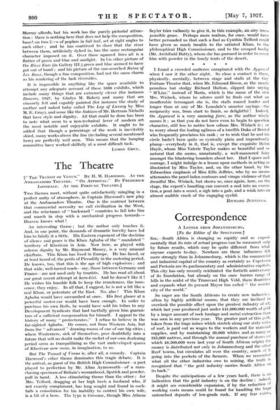Art
[SECOND THOUGHTS ON THE ROYAL ACADEMY.]
A SECOND visit to Burlington House left the impression that of all pictures in this year's exhibition none was likely to interest so many people as Mr. Frank Salisbury's The En- chanted Road. From the back seat of a closed motor the driver's head is seen in dim relief against the scorching illumination from the car's lamps, thrown along a stretch of road in wood_ land. Mr. Salisbury has set out with gusto to do a novel and difficult thing, and the result is exhilarating—and has its own quality of a startling beauty. Another canvas which must attract by its subject is also by Mr. Salisbury—the group of three Indian ladies, daughters of Mr. and Mrs. Riinsod Sen, which challenges comparison with other groupings of beautiful sisters; one by Sargent, one by Millais will come to everyone's mind.
I am still uncertain whether Mr. Walter Russell's Isabella is S° very good as it seemed at the first view. It is perhaps overloaded with detail ; vet the central design formed by the woman's figure and the curved arms is not obscured ; the lmeautiful things among which her beauty is set arc so merged that they merely make a pervading flicker of colour. Mr. Glyn Philpot's small portrait of Lord Esher is masterly ;
quiet harmonious colour, easy graceful lines make it, apart from its value as a portrait, a delightful ornament for an ordinary living-room. Of how many portraits can this be said ? Perhaps one of them would be Miss Katherine Clausen's study of Miss Dora Clarke, bold and significant in line and rich in colour. This hangs in the Gallery (No. XI.) specially devoted to the moderns. AMong them Miss Mary Adshead amused me with her Picnic, thliberately painted so as to resemble a tapestry ; the thin painting through which the canvas shows helps out the suggestion. It is a jolly piece of decoration ; and so is Leaving the Ark, by Miss Marian Ellis, which is a good joke as well ns a good colour scheme. Needless to say, the annuals r. re " stylized " not " representational," but her elephant is really elephantine. Stylized also are the figures in Mr. Eric George's Bathers, but they make a fine processional frieze.
It is surprising to meet in this company one of Mr. Henry Bishop's landscapes with their delicately contrasted tones. A lateen sail on one of the little craft off the rocky pier conveys that this is the Mediterranean, but those soft grays and pinks, relieved by the one patch which gives the title (The Green Boat) and the recession of the shore, might be in Cornwall. There are few living painters of landscape whose work, at its hest and within its limits, is more satisfying than Mr. Bishop's, and this is one of his good things.
Another small and attractive study of sea and shore is Mr. A. J. W. Burgess's Ripples on the Beach—chalky sea of the English Channel with tones of milk in the blue. Mr. George Graham's painting of Rochester is very good work which would have been new-fashioned forty years ago---all in a low key of Thames colour, without sunlight to bring in any meretri- cious blue. Mr. Terrick Williams' Morning at Menaggio shows that he has enjoyed the way an Italian lake-side moun- tain takes the dawn on its bosom in a pearly irradiation through mist. In the same Gallery (IX.), Sir II. Hughes-Stanton has two small studies of French landscape which gave me more pleasure than his large and important studies of the Riviera country in Galleries II. and III. This painter gets the form of ground without charm of atmosphere. The pattern of ridged lines in his picture of Cagnes is very skilful, but there is no illumination in his vision. Mr. Harry W. Adams under the title of Shadows into Herefordshire presents a winter land- scape in which a river valley winding like the letter " S " makes the basis of a fine composition and the belts of trees lie like tippets of fur on the snow. Better still as a composition iv Mr. Norman Lloyd's picture of the Middle Harbour, Sydney. Here the decorative idea springs from the windings and off- shoots of that lovely water ; the colour is strange to our eyes, for the trees which clothe the hill-bastions are blue-gum, and cloud shadows over them arc painted a deep cobalt.
Mr. R. M. Hughes gave me pleasure with his Alps from Bourg-dOisans ; it has " significant form " (to speak by the card) in the mountains which rise suddenly from the level of a meadow, seen through poplar poles, left bare (to help time composition), though all else is bursting into leaf.
In Gallery IV. Mr. La Thangue uses his paint coarsely, but Tying Watercress does give the feeling of strong grass with cattle on it in a water meadow of Southern England by a sunlit stream.
In the big room, Mr. Oliver Hall has a place of honour for his Morecambe Sands, in which a stratified sky reproduces the long horizontal lines of a wet foreshore and a road leading to it : the colour is echoed up and down, so that sky and shore seem of one quality. In the same room Sir David Murray's big canvas, Loch Morar, raises the whole question as to what landscape painting should do. This picture is exactly like a very beautiful Scotch lough : it recalls the kind of scenery that many of us ache after : and there is no use in saying that a coloured photograph could do as much, for one can feel the delight as well as the skill with which the painter has rendered the aerial insubstantial fabric into which mountains, in that opalescent atmosphere, often seem to merge under sunlight, as if they were of some translucent stone. But at the same time the picture is like a book which tells too much ; nearly all the foreground is tedious, though quite accurately represented : there is no selection, and where there is no selec- tion there can be no composition.
Now, Mr. Adrian Stokes with his River in France gives all the pleasure of reminiscence and association which Sir David Murray affords, but his work has the purely pictorial attrac-, tion : there is nothing here that does not help the composition, base on two of poplars in full leaf, set at right angles to each other ; and he has contrived to show that the river between them, artificially dyked in, has the same rectangular character imposed on it. Over these squared lines all is a flutter of green and blue and sunlight. In his other picture of the River Eure (in Gallery III.) green and blue seemed to have got out of hand ; and his picture of the sun-scorched Ruins of Les Baum, though a fine composition, had not the same charm as his rendering of the lush riversides.
It is impossible in anything like the space available to attempt any adequate account of these 1698 exhibits, which include many things that are extremely clever (for instance Dancers, 1927, by Gladys M. Baker) and many that are sincerely felt and capably painted (for instance the study of mother and naked baby called The Lap of Luxury by Miss M. E. Gray), and some like the Subiaco of Mr. Bertram Nicholls that have style and dignity. All that could be done has been to note what seem to a non-technical lover of modern art the most notable and enjoyable exhibits. It ought to be added that though a percentage of the work is inevitably skied, many works above the line (including several mentioned here) are perfectly well seen. This means that the hanging committee have worked skilfully at a most difficult task.
LEMON GREY.















































 Previous page
Previous page